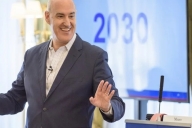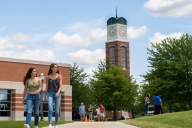You have /5 articles left.
Sign up for a free account or log in.
WASHINGTON -- "Did you kill anybody while you were in the military?"
It’s a provocative title for an education-related research paper, admits Lesley McBain, its author.
But it’s not an embellishment. The question is one that young veterans on college campuses routinely face, McBain said Friday during a presentation on student veterans at the annual meeting of the Association for the Study of Higher Education here.
She uses the question -- which she characterizes as "offensive" -- as the driving example of how student veterans are alienated by civilians.
But the question also is off-putting because it highlights a misunderstanding of student veterans -- many were never even in a position to kill someone.
In fact, despite varied topics, all three of the papers presented in the session on veterans suggested that higher education institutions carry misconceptions about and biases toward veterans that limit their ability to support them effectively.
Veterans are not a homogenous group of white males who have a shared experience of combat.
Instead, they are growing more diverse, in terms of gender, ethnicity and sexual orientation. There also are likely to be differences in their needs based on service status, whether active duty, veteran or reservist. A large population of veterans never served in combat; some have never even left the country.
McBain’s paper focused on the “othering of the veteran,” or the tendency of civilians to treat veterans as separate and different from civilians.
The majority of Americans don’t have direct connections to the military through family who are serving. Sixty percent of veterans under 40 have an immediate family member who is also a veteran, but only 39 percent of civilians under 40 do, according to the Pew Research Center.
That creates a gap between the civilian and military worlds that’s perpetuated by a mutual lack of understanding, said McBain, who's a third-year Ph.D. student at the University of California Los Angeles.
For civilians, the military is inseparable from death and violence, and for good reason, McBain said, as war is an integral part of the military's role.
But it's not the only part, and that’s something that civilians, including those in the higher education system, often fail to grasp, McBain said.
Student veterans are alienated in ways that other underrepresented groups in academe are not, McBain said.
Aside from the violence implied in what she terms “that question” about killing, McBain said veterans are boxed into other stereotypes, including intellectual (they weren’t smart enough for college, so they joined the military) or psychological (all veterans have post-traumatic stress disorder).
David Vacchi, a Ph.D. candidate at the University of Massachusetts at Amherst who studies student veterans, said the range of research on veterans at this year’s conference was refreshing after several years of sparse and inadequate work.
One paper found that certain characteristics of military training and service, such as forced responsibility and flexibility in solving problems, can help develop individuals’ level of self-authorship, or internal foundations.
The research, by Sharon Stone, who recently received a doctorate from the College of William & Mary, suggests that colleges should look into services for student veterans that are appropriate for their development, which may be more advanced than non-veterans.
Other research presented in the session focused on veterans’ perceptions of campus climate and whether that affects their academic success and their intent to continue with their program at that college.
Veterans perceive their level of academic success as high, but that’s not related to their intent to persist with schooling, according to the study by Frank Fernandez and Susan Rankin at Pennsylvania State University.
Civilian students were four times as likely as veterans and nearly six times as likely as active-duty military personnel to say they planned to graduate from the college at which they were enrolled.
That paper also highlighted one significant limitation to researching student veterans: identification.
While only 417 students identified themselves as veterans in the survey, 1,386 students said they’d experienced some kind of exclusionary behavior on campus and felt it was a result of being a veteran.
That suggests a large population of student veterans who aren’t included in studies because they aren’t identifying themselves.








